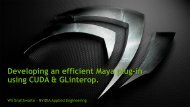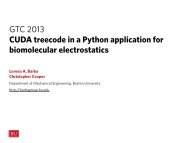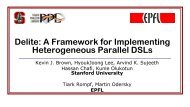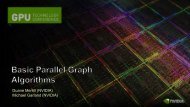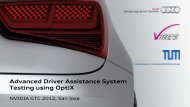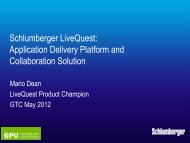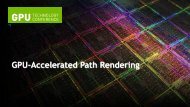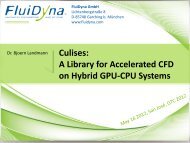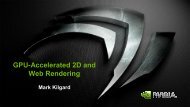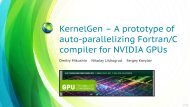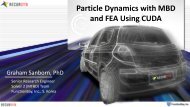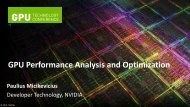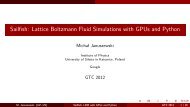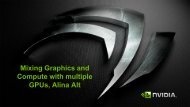GTC 2012 Program Guide - GPU Technology Conference
GTC 2012 Program Guide - GPU Technology Conference
GTC 2012 Program Guide - GPU Technology Conference
You also want an ePaper? Increase the reach of your titles
YUMPU automatically turns print PDFs into web optimized ePapers that Google loves.
TUESDAY<br />
TUESDAY, MAY 15, 17:00 (50 MINUTES)<br />
HALL 1<br />
S0156 Towards Computing the Cure for Cancer<br />
Attend this session to learn about how to create “designer”<br />
genomic analysis pipelines as part of the “Compute the Cure” for<br />
cancer initiative from NVIDIA Foundation. It will offer an overview<br />
of an open-source framework that enables the creation of<br />
customized genomic analysis pipelines. It will disucss how<br />
different plug-ins from the “mapping/realignment/discovery”<br />
repositories, respectively, can be composed to form a genomic<br />
analysis pipeline. Attendees will learn to use next-generation<br />
sequencing data to characterize previously undetectable genetic<br />
changes between normal and malignant cells and ways to<br />
contribute to the “Compute the Cure” cause.<br />
Speaker(s): Wu Feng (Professor, Virginia Tech), Heshan Lin (Research<br />
Scientist, Virginia Tech)<br />
Topic(s): Bioinformatics, Life Sciences, Supercomputing, Algorithms &<br />
Numerical Techniques (Intermediate)<br />
TUESDAY, MAY 15, 17:00 (25 MINUTES<br />
ROOM C<br />
S0219 Efficient Top-Down Planning in<br />
Business Intelligence<br />
In business intelligence, tasks like corporate planning or what-if<br />
analysis complement traditional reporting and analysis. One main<br />
difference is that while the latter only read data, the former<br />
require the change of possibly large numbers of existing and<br />
creation of new data records in the business model, preferably in<br />
real time. In this session, we describe the extension of an existing<br />
BI tool, Jedox OLAP, by <strong>GPU</strong>-based parallel algorithms for<br />
interactive planning scenarios. Compared to sequential inmemory<br />
algorithms, our CUDA approach yields tremendous<br />
speedups and can also cope with large amounts of data by using<br />
multiple <strong>GPU</strong>s.<br />
Speaker(s): Tobias Lauer (Senior Researcher, Jedox AG), Alexander<br />
Haberstroh (Software Developer, Jedox AG)<br />
Topic(s): Databases, Data Mining, Business Intelligence, Finance,<br />
Algorithms & Numerical Techniques (Intermediate)<br />
TUESDAY, MAY 15, 17:00 (50 MINUTES)<br />
MARRIOTT BALLROOM 3<br />
S0247 3D ADI Method for Fluid Simulation on<br />
Multiple <strong>GPU</strong>s<br />
Find out about a multiple <strong>GPU</strong> implementation of the Alternating<br />
Direction Implicit method for large 3D domains. The ADI technique<br />
is applied towards direct numerical fluid simulation. Modeling<br />
complex flows demands extremely large grids and a distributed<br />
computation is required for sharing the memory among multiple<br />
<strong>GPU</strong>s. In this session a novel distributed tridiagonal solver as well<br />
as parallelization and load balancing strategies will be covered in<br />
detail. Finally, a comprehensive performance analysis and scaling<br />
studies for different input geometries and possible future<br />
improvements will be discussed.<br />
Speaker(s): Nikolay Markovskiy (HPC DevTech Engineer, NVIDIA),<br />
Nikolai Sakharnykh (Developer <strong>Technology</strong> Engineer, NVIDIA)<br />
Topic(s): Algorithms & Numerical Techniques, Computational<br />
Fluid Dynamics (Intermediate)<br />
TUESDAY, MAY 15, 17:00 (50 MINUTES)<br />
ROOM J2<br />
S0267A Mixing Graphics and Compute with Multiple <strong>GPU</strong>s<br />
In this session we will cover all the different aspects of interaction<br />
between graphics and compute. The first part of the session will<br />
focus on compute API interoperability with OpenGL (using CUDA<br />
and OpenCL APIs), while the second part of the session will delve<br />
into interoperability at a system level. In particular we will go<br />
through the challenges and benefits of dedicating one <strong>GPU</strong> for<br />
compute and another for graphics, how different system<br />
configurations affect data transfer between two <strong>GPU</strong>s, and how it<br />
translates into application design decisions helping to enable an<br />
efficient, cross-<strong>GPU</strong> interoperability between compute and<br />
graphics contexts.<br />
This session is repeated on Thursday at 15:30 (S0267B).<br />
Speaker(s): Alina Alt (Applied Engineer, NVIDIA)<br />
Topic(s): Visualization Application Design & Porting Techniques<br />
(Beginner)<br />
TUESDAY, MAY 15, 17:00 (50 MINUTES)<br />
ROOM A5<br />
S0359 VMware and NVIDIA: Delivering 3D Workstations<br />
from the Cloud<br />
This session will detail the delivery of the most demanding<br />
Workstation class workloads from the private cloud using<br />
technologies from NVIDIA and VMware. We will cover the<br />
configuration and performance metrics of the combined VMware,<br />
NVIDIA direct pass through hardware accelerated graphics<br />
solution. Using sample workloads, we will demonstrate how<br />
customers can realize the operational and security benefits of<br />
cloud based personal computing without sacrificing performance.<br />
Speaker(s): Aaron Blasius (Sr. Product Manager, VMware), Warren<br />
Ponder (Director, Product Management, VMware)<br />
Topic(s): Visualization, Cloud Computing (Advanced)<br />
TUESDAY, MAY 15, 17:00 (50 MINUTES)<br />
ROOM L<br />
S0427 Intra-Day Risk-Management with Parallelized<br />
Algorithms on <strong>GPU</strong>s<br />
The challenge with intra-day risk management is that a very large<br />
number of calculations are required to be performed in a very<br />
short amount of time. Typically, we may be interested in<br />
calculating VaR for 100 to 1000 securities per second based on<br />
100 million potential scenarios. The magnitude of these<br />
calculations is not Utopian but it reflects the reality of modern<br />
financial institutions and exchanges. In this presentation, we<br />
outline how the complex problem of intra-day risk management<br />
can be solved using parallelized algorithms on <strong>GPU</strong>s. The<br />
methodology has been proven in a POC at 2 financial institutions.<br />
Speaker(s): Partha Sen (CEO, Fuzzy Logix)<br />
Topic(s): Databases, Data Mining, Business Intelligence, Finance,<br />
Algorithms & Numerical Techniques, Supercomputing (Advanced)<br />
TUESDAY, MAY 15, 17:00 (50 MINUTES)<br />
ROOM A3<br />
S0602 An Introduction to the Thrust Parallel<br />
Algorithms Library<br />
Thrust is a parallel algorithms library which resembles the C++<br />
Standard Template Library (STL). Thrust’s high-level interface<br />
greatly enhances developer productivity while enabling performance<br />
portability between <strong>GPU</strong>s and multicore CPUs. Interoperability with<br />
established technologies (such as CUDA, TBB and OpenMP)<br />
facilitates integration with existing software. In this talk we’ll walk<br />
though the library’s main features and explain how developers can<br />
build high-performance applications rapidly with Thrust.



